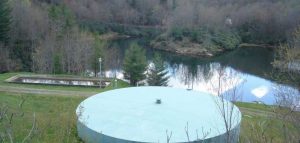Buckeye Lake
 Buckeye Lake is a “Flow-Through” reservoir which means that a regulated amount of water must spill over the dam and continue downstream to ensure the health of the water system beyond the lake. A minimum flow of 0.61 to 1.64 million gallons per day (MGD) must be released from the reservoir in compliance with the new 2019 Federal Government Requirement.
Buckeye Lake is a “Flow-Through” reservoir which means that a regulated amount of water must spill over the dam and continue downstream to ensure the health of the water system beyond the lake. A minimum flow of 0.61 to 1.64 million gallons per day (MGD) must be released from the reservoir in compliance with the new 2019 Federal Government Requirement.
The amount of water released downstream from Buckeye Lake must meet certain minimums, even during a drought. This is a State and Federal requirement. The previous minimums were not achievable during droughts such as the Town experienced in 2010. Therefore, the Town requested a modification to the dam permit issued by US Army Corps of Engineers. The new minimums approved are still significant (up to 1.64 MGD) but are more achievable. The new minimum release protocol is a major factor in calculating the supplemental water needed. The current estimated yield of 0.24 MGD is based on this protocol.
 The town’s average annual withdrawal of water from Buckeye Lake is 391,000 gallons of water a day (0.391 MGD), based on water plant production records. In the summer months, up to 900,000 gallons of water a day are used. In 20 years, assuming modest growth of 2% per year, the town would need about 500,000 gallons (on an average annual basis). The important fact to recognize is that our current and future water demand exceeds the yield of Buckeye Lake during times of drought.
The town’s average annual withdrawal of water from Buckeye Lake is 391,000 gallons of water a day (0.391 MGD), based on water plant production records. In the summer months, up to 900,000 gallons of water a day are used. In 20 years, assuming modest growth of 2% per year, the town would need about 500,000 gallons (on an average annual basis). The important fact to recognize is that our current and future water demand exceeds the yield of Buckeye Lake during times of drought.
Water Incidents
 In 2010, a drought caused the water level in Buckeye Lake to drop perilously close to empty, within inches of the level of the lowest intake pipe. This stopped the downstream flow and the town was within hours of not being able to meet the water needs of our residents.
In 2010, a drought caused the water level in Buckeye Lake to drop perilously close to empty, within inches of the level of the lowest intake pipe. This stopped the downstream flow and the town was within hours of not being able to meet the water needs of our residents.
A technical incident occurred in 2018 where a drain valve failed and almost the entire Lake was drained. Water tanker operations were instituted to supply water to the town. Distance from available water sources, and the inability of any neighboring systems to provide necessary volumes of water were discovered to be insurmountable obstacles to providing a continuous water flow for the town. This incident occurred during off season when town water consumption was dramatically lower. It is important to note that the tankers were not able to keep up with demand for water even during a period of low water consumption for the town.
A secondary water source would also provide reassurance and backup to help us overcome the many inherent risks that could affect the Town’s single source of water. Some examples include mechanical and physical damage, storm damage causing undesirable runoff, motor vehicle accidents and spills into the source or supply streams, droughts, and natural decline of incoming water flow. In these cases, water from the proposed intake would be pumped directly into the treatment plant, thus providing the Town with a protected secondary supplemental water source in the event Buckeye Creek becomes compromised.
Conclusion
A drought and technical malfunction are two reasons the town urgently needs to supplement its water system. Add to those incidents that the reservoir is a single source, with no backup to replenish in case of emergency, and the need for a second water source is evident.

